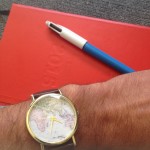Today, a rainy Saturday, with my headphones broken and a mind recently activated by coffee I sat silently for the duration of my hour long ride on the 86 Tram and began to consume any information readily available. The carriages were riddled with posters containing images, text and symbols to convey the rules and regulations of Melbourne’s Metro. For a form of text whose whole basis lies in clear and concise messages there’s peculiarity in the vast differences between their denotations and connotations (first and second order meanings). Hardly had I noticed before the amount of assumed knowledge we bring to interpret messages such as these.
It is after all a huge leap from the sign of white circle and lines on a blue background to identify a person in a wheelchair, which in turn comes to represent all persons with disabled mobility, and stands as a symbol that there are sufficient mechanics in place (a ramp, a handrail) to allow access for such persons, and further that they shall be given priority access to the service nearby. Even by following the length and structure of the above sentence we see the lengthy, still not exhaustive, process we take as everyday viewers, consumers, audiences, humans, to understand even the simplest of texts. Crucial to the importance of this pictures cohesion is that the same shapes, in another context, would not be perceived in the same way. Simultaneously, a perfectly sketched portrait of some-one in a wheelchair would not be received identically.
Key to the effectiveness of such informative texts are their strong conventions. Relying heavily on visual aspects to transcend barriers of language and literacy each poster I saw contained only simple or fine text if any, pertaining to the precise technicalities rather than the dominant meaning. The typical poster used gender and age unspecific drawings, simple depictions of other objects were greyscale – this use of objective characterisation limited the play between the authors intentions and the audience response. Other techniques of colour and framing enhanced this unidirectional movement typical of its form. Also crucial to the successful functioning of cautionary, and safety signs are their external conventions, including their placement, and greater salience. We look overhead and near entries and exits for information, an exit sign on the right hand side of a corridor is read differently to one in the centre.
Our ability to interpret and understand these texts is developed over time, from reading, repetition, and recognition, actions all taken predominantly by the subconscious. It was in fact as recent as 1984 that the identifiable “no symbol”, a red circle with a diagonal line on a white background had a publishing standard in the UK. In the last thirty years it has efficiently created a social and cultural code allowing it to be read universally (in the sense limited to its use, rather than a literal sense of universal.) Continuing to observe the way that I receive texts from an audience perspective will greater enhance my understanding of the techniques and approaches in regards to connotations, signs and codes that I can use as a producer to create meaning.
